Even 70 years later, one of the most common questions asked by tourists visiting Atlanta is “Where is Tara?” Not where is Coca Cola, where is CNN or where is Olympic Park. They want to see the iconic antebellum home where Scarlett flirted with her beaus and later, having been brought low by the war, gnawed a turnip and vowed never to go hungry again.
The real Tara doesn’t exist. It was a Hollywood invention and a fantasy in the minds of screenwriters who took the original modest middle-class dwelling of Margaret Mitchell’s vaguely autobiographical novel and re-imagined it as the quintessential southern plantation house.
In fact, none of the scenes in Gone with the Wind were shot in Atlanta. The film was shot entirely in California. But that doesn’t stop people from going to Atlanta to find it.
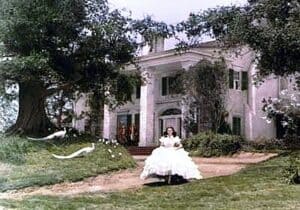
The real Tara doesn’t exist. It was a Hollywood invention and a fantasy in the minds of screenwriters.
Groundbreaking and Audacious
Perhaps no movie is more associated with a place than Gone with the Wind. Margaret Mitchell’s panoramic tale of the fall and rise of Scarlett O’Hara and the Civil War era South is an American fable of such power and resonance that even today it has the ability to bring viewers to tears.
Gone with the Wind was ahead of it’s time. At a time when nearly all movies were about white males, this was a movie about females. What’s more, African-Americans played pivotal roles. At a time when Tarzan movies were still painting white actors in black face to portray Africans, Hattie McDaniels won an Oscar for her role as Mammy in the film.
Scarlett O’Hara, a Different Kind of Heroine
Seen through the prism of today’s sensibilities, Scarlett O’Hara is the perfect anti-hero. Deeply flawed, at times downright contemptible, she nevertheless wins our admiration.
While anti-heroes are common today, in 1939 the idea that the hero could be so petty, narcissistic and ruthless was unimaginable – until one saw the movie. And what they saw was a character more complex and realistic than anything they had seen before.
Gone with the Wind made people examine themselves as individuals and as Americans at a time when the nation was about to embark on one of its greatest challenges. One month after the movie’s premier the Nazis invaded Poland, setting off World War II.
Atlanta Under Siege

After a series of flanking movements, the Union Army confronted the Confederate Army at Kennesaw Mountain.
With all this to inform it, it’s little wonder Gone with the Wind still holds Americans in its thrall. In Atlanta, the city and its surrounding communities have had to be inventive to answer tourists’ demands to see something of its legacy. By the 1980’s even the theater it premiered in had been gutted by fire and torn down. The sets and costumes had been dismantled or lost. Only the tiny depression-era apartment where Margaret Mitchell had written the book remained, although it was dilapidated and boarded up.Still, that was a start, that and the battlefield.
The Battle of Kennesaw Mountain was a turning point in the American Civil War and the first domino to fall in what would become the defeat of Atlanta. Today Kennesaw Mountain National Battlefield Park is a 2884 acre site comprised of  16 miles of hiking trails and activity grounds. The park is a favorite haunt of joggers, hikers and picnickers from nearby Marietta. A self-guided cell phone audio tour walks history buffs through the events of June 27, 1864.
16 miles of hiking trails and activity grounds. The park is a favorite haunt of joggers, hikers and picnickers from nearby Marietta. A self-guided cell phone audio tour walks history buffs through the events of June 27, 1864.
After a series of flanking movements, the Union Army under General William T. Sherman confronted the Confederate Army at Kennesaw Mountain. While the Union Army lost 3,000 men in the frontal assault, it was able to exploit a weakness and force a Confederate withdrawal. It was the beginning of the end for the Confederacy and for Atlanta. In little more than a month, Sherman had Atlanta under siege.
The Invaluable Devotion of Collectors
In the movie, Scarlett is caught in Atlanta as the city comes under Union bombardment. It is her strength under pressure that most impresses the viewer who soon grasps that her frivolous romantic obsessions up until now are but trifling aspects of the fierce tenacity at her core.
At the Marietta Gone with the Wind Museum these qualities of Scarlett are on display, as are a wide range of cinematic artifacts collected here in a former cotton warehouse. The fruits of the extensive collection of Dr. Chris Sullivan, an Akron, Ohio endocrinologist and Gone with the Wind aficionado, the 1,500 square foot museum is strong on rare editions of the novel and promotional items, including film posters, premiere programs, conceptual artworks, advertisements and collectibles. Its centerpiece is the original Bengaline honeymoon gown worn by Vivien Leigh in her portrayal of Scarlett.
 The development of a viable Gone with the Wind tourist industry owes much to the devotion of collectors like Sullivan. If it hadn’t been for them, there wouldn’t have been much left to show people by the time Atlanta woke up to what it had.
The development of a viable Gone with the Wind tourist industry owes much to the devotion of collectors like Sullivan. If it hadn’t been for them, there wouldn’t have been much left to show people by the time Atlanta woke up to what it had.
It’s telling that all of this was only put on display here in 2003, some 63 years after the film first premiered. If Atlantans went through a long stretch wondering when visitors would finally stop asking “Where is Tara?” by the 1990’s they knew that the film’s appeal was for the ages, and they got about the business of promoting it.
Frankly, Margaret, I don’t give a damn
The best of the Gone with the Wind attractions is the Margaret Mitchell House and Museum. Located in downtown Atlanta, it is the original ten-unit brick apartment building where Mitchell wrote the novel from 1925 to 1932. Having survived a period of decline and abandonment, the building was restored in 1995 and opened to the public in 1997.
Today, trained docents walk you through the events of Mitchell’s life revealing this remarkable woman who, it soon becomes clear, was the real life model for the fictional character of Scarlett O’Hara. Mitchell, like her heroine, was sassy, flirtatious, irresistible to men, and not to be trifled with. Considerably ahead of her time, Mitchell defied convention to become one of the first female journalists at the Atlanta Journal.
 Her love life raised eyebrows in the 1920’s when, like her character, she entertained the advances of two men at the same time. One was bookish and courtly, like Ashley Wilkes, the other brash and daring, a gambler and lady’s man named Red Berrian. The similarity to the name Rhett Butler is not coincidental. For a time, she cohabitated with both men, and eventually married Red, only to divorce him two years later after he became abusive. It is not a stretch to imagine him growling, “Frankly, Margaret, I don’t give a damn.” Soon after her divorce she married her other lover, John Marsh, who came to be her muse.
Her love life raised eyebrows in the 1920’s when, like her character, she entertained the advances of two men at the same time. One was bookish and courtly, like Ashley Wilkes, the other brash and daring, a gambler and lady’s man named Red Berrian. The similarity to the name Rhett Butler is not coincidental. For a time, she cohabitated with both men, and eventually married Red, only to divorce him two years later after he became abusive. It is not a stretch to imagine him growling, “Frankly, Margaret, I don’t give a damn.” Soon after her divorce she married her other lover, John Marsh, who came to be her muse.
After having read nearly every novel in the Atlanta Public Library, Margaret complained there was nothing left to read, which is when John told her she would just have to write her own novel. Thus began the seven year project that would become Gone with the Wind. Published in 1936 the book became an overnight sensation and a huge national bestseller.
At the museum you are guided through the tiny three room apartment where the book was written. Much of the original furniture is preserved, and visitors gets a real sense of the straitened circumstances in which the author and her husband lived at the time of its composition. By the time the movie came out three years later, Margaret Mitchell was the toast of Atlanta and considerably better off financially.
Pot Likker and “Honey Pies”
 After touring the museum, a great complement to the experience is lunch at Mary Mac’s Tea Room. About eight blocks south of the Margaret Mitchell House, this bastion of authentic southern cooking is actually seven rooms, a sprawling multi-faceted eatery belied by its understated storefront and demure moniker. As it turns out, back in 1945 “tea room” was a polite way of downplaying the fact that a woman – gasp! – was running a restaurant, something many war widows did to make ends meet.
After touring the museum, a great complement to the experience is lunch at Mary Mac’s Tea Room. About eight blocks south of the Margaret Mitchell House, this bastion of authentic southern cooking is actually seven rooms, a sprawling multi-faceted eatery belied by its understated storefront and demure moniker. As it turns out, back in 1945 “tea room” was a polite way of downplaying the fact that a woman – gasp! – was running a restaurant, something many war widows did to make ends meet.
Mary Mac’s restaurant flourished over the years and today you can enjoy buttered peas, fried okra, pickled beets, turnip greens, pot likker and corn bread, as well as fried chicken, roasted pork and “the best iced tea in the South”. The service is prompt and friendly with lots of “darlins” and “honey pies” and the price is right. My waitress was actually named Flo.
The Road to Tara
While you are filling your stomach at Mary Mac’s you may recall that Scarlett was starving as Atlanta fell. That’s because Union forces cut off Confederate supply lines by moving troops into the town of Jonesboro south of Atlanta.
Driving out to suburban Jonesboro today you will pass Dollar General Stores and squat brick Baptist churches and arrive at the place where Union troops tore up the tracks, heating them up and twisting them around trees, making what were called “Sherman neckties”, so the Confederate troops couldn’t replace them.
In the historic train depot at Jonesboro you will find the Road to Tara Museum, opened at this location in 2000. Here are items from the collection of Herb  Bridges, a historian and collector who, as a teenager, worked as an usher at the Loews Grand Theatre where Gone with the Wind premiered. On display are reproductions of several of the famous dresses from the film, as well as the actual cotton pantalettes worn by Vivien Leigh in the famous scene where Mammy helps her get dressed for the barbeque.
Bridges, a historian and collector who, as a teenager, worked as an usher at the Loews Grand Theatre where Gone with the Wind premiered. On display are reproductions of several of the famous dresses from the film, as well as the actual cotton pantalettes worn by Vivien Leigh in the famous scene where Mammy helps her get dressed for the barbeque.
In addition there is a Civil War exhibit explaining the Battle of Jonesboro as well as collectibles related to the film and several sound stations where actor Fred Crane, who played Brent Tarleton in the film, reminisces about the making of the film.
The Significance of Square Pillars
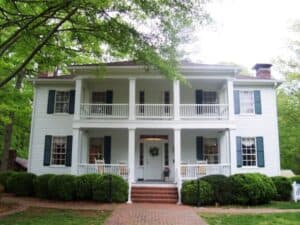
The folks at Stately Oaks don’t claim it was the model for Tara, but they don’t claim it wasn’t either.
Yet with all of this, the question remains, “Where is Tara?” In an attempt to address that, the Jonesboro historical society moved the 1839 Greek revival mansion known as Stately Oaks to it current location in the 1970’s and opened it for tours. While the historical society does not claim Stately Oaks was the original model for Tara, it does point out that Margaret Mitchell was familiar with the place and that Mitchell’s Tara featured square pillars, just like the ones at Stately Oaks.
If you are eager to imagine yourself at Tara, the costumed docents at Stately Oaks will try to accommodate you. The house, most likely smaller than the Tara of your imagination, consists of only eight rooms. The tour features accounts of people left behind on the plantation while the men went off to war, and the docents are knowledgeable about the history of the period and the details of the movie.
 If you arrive in Jonesboro during tourist season, you can arrange for a shuttle bus tour of the Jonesboro area, which includes the Road to Tara Museum and Stately Oaks and features actors in period costumes. Contact the Road to Tara Museum for more details.
If you arrive in Jonesboro during tourist season, you can arrange for a shuttle bus tour of the Jonesboro area, which includes the Road to Tara Museum and Stately Oaks and features actors in period costumes. Contact the Road to Tara Museum for more details.
Answering the Question
Gone with the Wind sits squarely in the arc of our history. The same number of years has passed between the end of the Civil War and the making of the film as have passed between the premier of the film and today.
As a depiction of American resolve and tenacity in the face of crisis it helped inspire a nation on the brink of war, and as an insight into the complexity of the  human character it still stands among the finest of American films.
human character it still stands among the finest of American films.
While Atlanta went through a long stretch where it virtually ignored the legacy of Gone with the Wind, since the early 90’s it has been busily correcting that situation, and today there are plenty of ways they can answer that most common of questions: “Where is Tara?”
Interactive Gone with the Wind Tour map
Other Tour Itineraries on My American Odyssey
Previous stop on the odyssey: Boone, NC //
Next stop on the odyssey: Jasper, AR
Image Credits:
Vivien Leigh as Scarlett O’Hara, Public Domain; Scarlett and Tara, Public Domain; Battle of Kennesaw Mountain by Kurz and Allison, Public Domain; Kennesaw Mountain cannon, Mike Reichold; Oil Paintings, Malcolm Logan; Marietta Gone with the Wind Museum, Malcolm Logan; Margaret Mitchell, Malcolm Logan of an image at the Margaret Mitchell House; Margaret Mitchell’s apartment, Malcolm Logan; Rhett Butler, Public Domain; Mary Mac’s Tea Room, Malcolm Logan; Road to Tara Museum exterior, Malcolm Logan; Stately Oaks, Historicaljonesboro.org; Road to Tara Museum interior, Dierdre

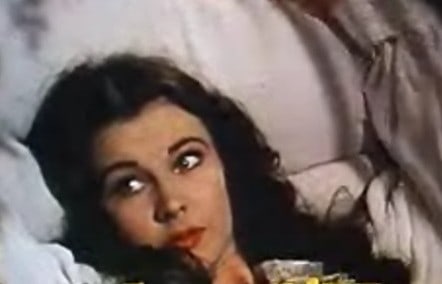




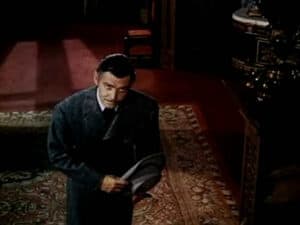


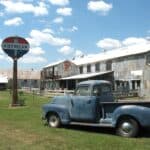




4 comments
[…] stop on the odyssey: Atlanta, GA // Next stop on the odyssey: Jasper, […]
[…] Atlanta, GA “Where is Tara?” Atlanta’s Gone with the Wind Legacy […]
[…] “Where is Tara?” Atlanta’s Gone with the Wind Legacy […]
[…] “Where is Tara?” Atlanta’s Gone with the Wind Legacy […]